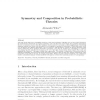Free Online Productivity Tools
i2Speak
i2Symbol
i2OCR
iTex2Img
iWeb2Print
iWeb2Shot
i2Type
iPdf2Split
iPdf2Merge
i2Bopomofo
i2Arabic
i2Style
i2Image
i2PDF
iLatex2Rtf
Sci2ools
ENTCS
2011
2011
Symmetry and Composition in Probabilistic Theories
The past decade has seen a remarkable resurgence of the old programme of finding more or less a priori axioms for the mathematical framework of quantum mechanics. The new impetus comes largely from quantum information theory; in contrast to work in the older tradition, which tended to concentrate on structural features of individual quantum systems, the newer work is marked by an emphasis on systems in interaction. Within this newer work, one can discerne two distinct approaches: one is “top-down”, and attempts to capture in category-theoretic terms what is distinctive about quantum information processing. The other is “bottom up”, attempting to construct non-classical models and theories by hand, as it were, and then characterizing those features that mark out quantum-like behavior. This paper blends these approaches. We present a constructive, bottom-up recipe for building probabilistic theories having strong symmetry properties, using as data any uniform enlargement of the...
| Added | 14 May 2011 |
| Updated | 14 May 2011 |
| Type | Journal |
| Year | 2011 |
| Where | ENTCS |
| Authors | Alexander Wilce |
Comments (0)

